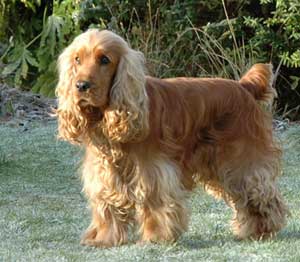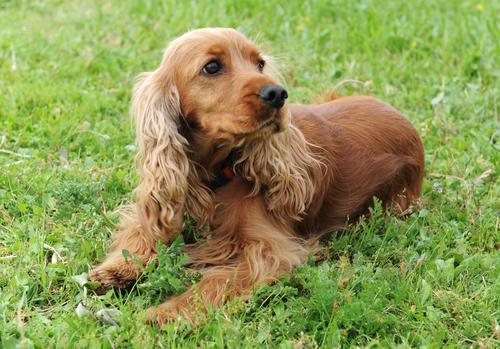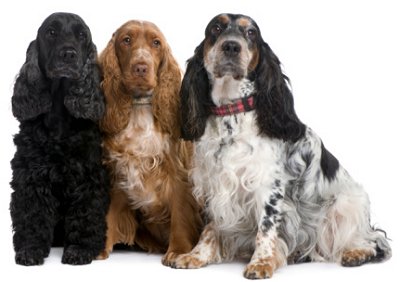
The Breed History
The Cocker Spaniel is the smallest member of the sporting division,
and resulted from the selection of small dogs from the land spaniel
group. Breed status was given to this dog in 1892 (England Kennel
Club). After import to the USA around 1880, the American type
became distinct from the English cocker type, being shorter, heavier
coated and having a rounder skull, and now are two quite distinct
breeds; American and English Cocker Spaniel. The American cocker
is often just termed Cocker Spaniel. The feature role of a cocker
type dog in the cartoon "Lady and the Tramp" by Disney resulted in
a large sudden surge of the popularity of this breed.
Breeding for Function
This dog was bred to be a hunting dog, and though considered a
land spaniel, will work in water readily. The name cocker is thought
to derive from "woodcock", game that they were particularly suited
for. Today, they commonly serve as a valued home companion,
enjoy agility competitions, and still maintain status as one of the
most popular AKC breeds.
Physical Characteristics
Height at Withers: female 14" (35.5 cm), male 15" (38 cm)
Weight: females 24-26 lb (11-12 kg), males 26-28 lb (12-13 kg).
Coat: The long silky fine straight to slightly wavy coat is seen in
black, cream, red, brown, parti-colored (one color must be white),
and a tan point variety (less than 10% coat colored). For solid coats,
only small white markings on chest and throat are acceptable. Show
divisions by color include solid non-black, black and parti-color.
They are well feathered on ears, legs, abdomen and chest.
Longevity: 13-16 years.
Points of Conformation: This is a very balanced, medium length
and sized dog, with a refined broad head, large square muzzle and
slightly arched long neck. Eyes are large, round and dark brown in
color. Ears are long, reaching to the nose and well-feathered, and
the leather is thick. The head has a pronounced stop, nose is dark
(black, brown, liver). Ribs are well-sprung and the topline slopes
slightly downward to a docked tail carried level with the back.
Dewclaws may be removed. Their gait is straight and low.
Recognized Behavior Issues and Traits
These dogs are gentle social dogs that are playful and affectionate
with family members, and very loyal. They are considered of
medium trainability, and are generally good with children. Early
socialization and training is very important for these dogs.
Those poorly socialized and of timid personality may be snappy,
and some lines are known to have temperament changes such
as fearful-dominant personalities. These lines may also be
dominant-aggressive. For the most part this breed has been
carefully selected for gentle, friendly personality. They need plenty
of exercise and play time.
They require regular ear hygiene and lots of coat care, with average
shedding. They have an average to high barking tendency.
Normal Physiologic Variations
None reported
Drug Sensitivities
None reported
Inherited Diseases
Patella Luxation: Polygenically inherited laxity of patellar
ligaments, causing luxation, lameness, and later degenerative joint
disease. Treat surgically if causing clinical signs. OFA reports 18.0%
affected.
Hip Dysplasia: Polygenically inherited trait causing degenerative
joint disease and hip arthritis. OFA reports 6.5% affected.
Progressive Retinal Atrophy (prcd-PRA): Autosomal recessive
progressive rod cone degeneration (prcd) form. Age of onset
between 3-5 years, eventually causing blindness at 5-7 years. A
genetic test is available. CERF does not recommend breeding any
Cocker Spaniel with PRA.
Elbow Dysplasia: Polygenically inherited trait causing elbow
arthritis. OFA reports 1.0% affected.
Sry-negative XX Sex reversal (Hermaphrodism): An autosomal
recessive disorder, where outwardly male dogs are chromosomal
females (XX), and there is an absence of male causing SRY. A
genetic test is not available, however a linked marker has been
found.
Disease Predispositions
Distichiasis: Abnormally placed eyelashes that irritate the cornea
and conjunctiva. Can cause secondary corneal ulceration. Dorn
reports a 6.08x odds ratio versus other breeds. Identified in 38.24%
of Cocker Spaniels CERF examined by veterinary ophthalmologists
between 2000-2005. Reported at a frequency of 5.9% in the 2005
Cocker Spaniel Comprehensive Breed Health Survey.
Bronchiectasis: Clinical signs of chronic cough with excessive
airway mucous. Diagnosis with radiographs. Reported at a
frequency of 15.9% and an odds ratio of 4.15x versus other breeds.
Treatment is with bronchodilators and possibly corticosteroids.
Hypothyroidism: Inherited autoimmune thyroiditis. 15.7% positive
for thyroid auto-antibodies based on testing at Michigan State
University. (Ave. for all breeds is 7.5%). Reported at a frequency
of 3.8% in the 2005 Cocker Spaniel Comprehensive Breed Health
Survey.
Behavioral Disorders: The 2005 Cocker Spaniel Comprehensive
Breed Health Survey reports 10.5% of Cocker Spaniels with
behavioral disorders. These include submissive urination (4.7%),
separation anxiety (4.4%), and fearfulness towards; people (3.9%),
noise (3.9%), children (2.5%), and their environment (2.5%).
Retinal Dysplasia: Focal retinal dysplasia and retinal folds are
recognized in the breed. Severe cases can progress to retinal
detachment. Reported in 10.04% of Cocker Spaniels CERF examined
by veterinary ophthalmologists between 2000-2005.
Chronic Otitis with Ossification of the External Ear Canal:
Cocker Spaniels are prone to chronic ear infections, and to
dystrophic ossification and closing down of the external ear canal.
Dorn reports a 1.45x odds ratio versus other breeds. A Greek
study reported a 8.99x odds ratio versus other breeds. Chronic ear
infections were reported at a frequency of 9.0% in the 2005 Cocker
Spaniel Comprehensive Breed Health Survey.
Cataracts: Anterior and posterior cortex intermediate and punctate
cataracts predominate in the breed. Onset of cataracts may
occur at less than 2 years, with rapid progression to maturity and
associated with significant lens-induced inflammation. Reported
at a frequency of 8.77% in one study. Identified in 6.96% of Cocker
Spaniels CERF examined by veterinary ophthalmologists between
2000-2005. Reported at a frequency of 5.9% in the 2005 Cocker
Spaniel Comprehensive Breed Health Survey. Dorn reports a 2.04x
odds ratio versus other breeds. One study showed a 2.6x odds
ratio versus other breeds. CERF does not recommend breeding any
Cocker Spaniel with a cataract.
Glaucoma: Ocular condition causing increased pressure within
the eyeball, and secondary blindness due to damage to the retina.
Diagnose with tonometry and gonioscopy. One study shows
5.52% Cocker Spaniels affected; the highest frequency of primary
glaucoma versus other breeds. A female preponderance occurs
in the breed. Secondary glaucoma can also occur after cataract
formation in the breed. One report found an odds ratio of 3.7x for
secondary glaucoma in Cocker Spaniels. Dorn reports a 5.73x odds
ratio for glaucoma versus other breeds. CERF does not recommend
breeding any Cocker Spaniel with glaucoma.
Allergic Dermatitis: Inhalant or food allergy. Presents with pruritis,
otitis, and pyotraumatic dermatitis. Reported at a frequency of 5.1%
in the 2005 Cocker Spaniel Comprehensive Breed Health Survey.
Prolapsed Gland of the Nictitans (Cherry Eye): This condition is
secondary to chronic conjunctivitis, usually of an allergic nature.
Reported at a frequency of 4.4% in the 2005 Cocker Spaniel
Comprehensive Breed Health Survey. Dorn reports a 2.06x odds
ratio for conjunctivitis versus other breeds.
Epilepsy: Inherited seizures. Can be generalized or partial seizures.
Reported at a frequency of 3.6% in the 2005 Cocker Spaniel
Comprehensive Breed Health Survey.
Keratoconjunctivitis Sicca (KCS), Chronic Superficial
Keratitis (Pannus), Dry Eye: These ocular conditions can cause
conjunctivitis, corneal ulcerations, and vision problems due to
corneal pigmentation. Age of onset 2-5 years. Treatment with
topical ocular lubricants and anti-inflammatory medication. Pannus
was identified in 0.77% of Cocker Spaniels CERF examined by
veterinary ophthalmologists between 2000-2005. KCS is reported
at a frequency of 3.4% in the 2005 Cocker Spaniel Comprehensive
Breed Health Survey. CERF does not recommend breeding any
Cocker Spaniel with KCS.
Aggression: The breed is one identified with a tendency toward
severe dominance aggression. This may be most extreme in intact
males, though neutered males and females can also be affected.
Reported at a frequency of 3.3% in the 2005 Cocker Spaniel
Comprehensive Breed Health Survey.
Umbilical Hernia: Reported at a frequency of 2.9% in the 2005
Cocker Spaniel Comprehensive Breed Health Survey.
Deafness: In the Cocker Spaniel, this can be congenital, or
secondary to severe, chronic otitis. Can be bilateral or unilateral.
Diagnose with BAER testing. Reported at a frequency of 2.8% in the
2005 Cocker Spaniel Comprehensive Breed Health Survey.
Corneal Dystrophy: The breed can develop a posterior
polymorphous dystrophy that does not lead to corneal edema.
Identified in 2.47% of Cocker Spaniels CERF examined by veterinary
ophthalmologists between 2000-2005.
Ectropion: Ectropion, a rolling out of the eyelids, can cause
frequent conjunctivitis, and ocular discharge. Identified in 1.52%
of Cocker Spaniels CERF examined by veterinary ophthalmologists
between 2000-2005.
Immune-Mediated Hemolytic Anemia (IMHA) and Idiopathic
Thrombocytopenia Purpura (ITP): Autoimmune destruction of
blood cells. Cocker Spaniels have a 12.2x odds ratio for IMHA versus
other breeds. Females are more frequently affected than males.
Unknown mode of inheritance. IMHA is reported at a frequency of
1.0%, and ITP at 0.7% in the 2005 Cocker Spaniel Comprehensive
Breed Health Survey.
Idiopathic Seborrhea: Primary inherited skin disorder presenting
with greasy skin and haircoat. Unknown mode of inheritance. The
condition responds to treatment with etretinate. Dorn reports a
3.19x odds ratio versus other breeds.
Dilated Cardiomyopathy: The breed can develop a taurine
responsive dilated cardiomyopathy. Affected dogs present in
heart failure, and have very low plasma taurine levels. Most
affected dogs show a significant (clinical and ECHO) response to
taurine supplementation and can usually be weaned off heart
medications.
Vitamin A responsive Dermatosis: Inherited skin disorder
presenting with seborrhea and keratinization. Differentiated from
idiopathic seborrhea by skin biopsy and responsiveness to Vitamin A
supplementation.
Second and Third Degree Heart Block: Cocker Spaniels are a
breed listed as predisposed to high-grade second- or third-degree
AVB. The breed is also at risk for sick sinus syndrome. Heavier,
older, and sexually intact female dogs were overrepresented in the
study group. Weakness, lethargy, exercise intolerance, and syncope
were the most common clinical signs. Pacemaker implantation is
recommended.
Plasmacytoma/Plasma Cell Tumor: Cocker Spaniels were found to
have a 10.0x greater risk of developing plasma cell tumors of the
tongue than other breeds. Other published case reports document
plasmacytoma of the penis, anus and 3rd eyelid. This is a benign
tumor, and treatment is with surgery.
Ceroid-Lipofuscinosis: Rare, fatal degenerative neurological
disease. Affected Cocker Spaniels have presented between 18
months and 6 years of age with variable signs of progressive hind
limb paresis, incoordination, behavior changes, seizures, and/or
blindness. Unknown mode of inheritance.
Incomplete Ossification of the Humeral Condyle: Cocker Spaniels
have an increased incidence of incomplete ossification of the
humeral condyle, and associated humeral condylar fractures or
degenerative joint disease. There is a male preponderance. A recessive
mode of inheritance was suggested based on pedigree analysis.
Episcleritis: Cocker Spaniels are over-represented with a diagnosis
of diffuse or nodular episcleritis. Affected dogs can show unilateral
or bilateral inflammation and congestion of the scleral vessels
with corneal edema and stromal infiltrate of CD3 T-lymphocytes.
In one study, 6 of 19 cases were Cocker Spaniels. Treatment is with
immunosuppressive medications.
Abnormal Platelet Function: Moderate to severe bleeding due to
platelet ADP deficiency was identified in 3 families of dogs. Platelet
counts, plasma coagulant function and von Willebrand factor are
normal, but there is prolonged bleeding time, prolonged platelet
aggregation time in response to ADP and collagen.
Oral Malignant Melanoma: Malignant cancer usually involving the
gingiva. Can be pigmented or non-pigmented. One study identified
a 1.65x relative risk versus other breeds.
Isolated Case Studies
Nasal Dermoid Sinus Cysts: A few cases have been reported
in Cocker Spaniels. Affected dogs present with a subcutaneous
mass or draining tract over the midline bridge of the nose.
Surgical removal is curative. In another case study, an intracranial
epidermoid cyst caused syringomyelia.
Lipid Storage Myopathy: A six-year-old male Cocker Spaniel
presented with a three-week history of generalized weakness
and muscle pain. Muscle biopsies revealed numerous large lipid
droplets within type 1 fibres and to a lesser degree within type 2
fibres. Biochemical testing showed elevated urinary excretion of
lactic, pyruvic and acetoacetic acids, increased urinary excretion of
carnitine esters, and increased plasma alanine, consistent with a
block in oxidative metabolism.
Progressive Ataxia with Seizures: Case history of a young male
Cocker Spaniel with progressive neurological disease evident by
3 months of age, and progressing to uncontrollable seizures by
15 months. Significant lesions were found only in the brain. They
consisted of hypoplasia of the cerebellum and the presence of large
pale proteinacious inclusions in the perikaryon of neurons in the
neocortex and in macrophages.
Congenital Myotonia: A 16-week-old, male Cocker Spaniel
suffered from pelvic-limb "bunny hopping" as well as rigidity,
spasticity, and ataxia in all limbs. Electrophysiology, and muscle
histopathological and histochemical evaluations led to a diagnosis
of congenital myotonia.
Focal Myasthenia Gravis: A 10-month-old dog presented with
megaesophagus, aspiration pneumonia, no appendicular muscle
weakness, but facial muscle weakness. The condition responded
to anticholinesterase, and serum antibodies against acetylcholine
receptors were documented.
Cerebellar Vermian Hypoplasia: An eight-week-old female
Cocker Spaniel was presented with ataxia, dysmetria and intention
tremor. Cerebellar hypoplasia with vermal defect was identified on
necropsy, comparable to Dandy-Walker syndrome.
Phosphofructokinase Deficiency (PFK): A 3-year-old female
American Cocker Spaniel with chronic hemolytic crises was
identified with the same mutation found in the autosomal recessive
disorder of the English springer spaniel.
Dimelia: A Cocker Spaniel was examined with two left forelimb
paws, both originating from the carpus, with symmetrical
duplication of metacarpal bones and phalanges. In addition, the left
radial head was subluxated and asynchronous growth of the left
radius and ulna was noted.
Black hair Follicular Dysplasia, Brachygnathism, Chronic
Inflammatory Hepatic Disease, Cleft Lip/Palate, Cryptorchidism,
Cyclic Hematopoiesis, Ectodermal Defect, Factor IX Deficiency,
Factor X Deficiency, Hypotrichosis, IgA Deficiency, Intervertebral
Disc Disease, Malignant Hyperthermia, Microphthalmia,
Narcolepsy, Optic Nerve Coloboma and Hypoplasia, Pelger-Huet
Anomaly, Portosystemic Shunt, Prognathism, Pulmonic Stenosis,
Renal Dysplasia, Sebaceous Adenitis, Vascular ring Anomaly and
von Willebrand's Disease are reported.
Genetic Tests
Tests of Genotype: Direct test for prcd-PRA is available from
Optigen.
Direct test for Phosphofructokinase deficiency is available from
HealthGene, Optigen, PennGen, and VetGen (very rarely seen in the
breed).
Direct tests for coat colors (black, brown and buff/red) are available
from HealthGene and VetGen.
Tests of Phenotype: CHIC Certification: Required testing includes
hip radiographs, and CERF eye examination. (See CHIC website;
caninehealthinfo.org).
Additional Recommended tests include patella evaluation, thyroid
profile including autoantibodies, elbow radiographs, and cardiac
evaluation.
Miscellaneous
- Breed name synonyms: Cocker, Cocking Spaniel, Cocker Spaniel.
- Registries: AKC, UKC, CKC, KCGB (Kennel Club of Great Britain),
ANKC (Australian National Kennel Club), NKC (National Kennel Club)
- AKC rank (year 2008): 21 (9,481 dogs registered)
- Internet resources: American Spaniel Club of America:
asc-cockerspaniel.org
American Cocker Spaniel Club of Canada: acscc.ca
American Cocker Spaniel Club of Great Britain: acscgb.com
Photo Gallery of Breed - Cocker Spaniel - Dog Breed








 Animalia Life
Animalia Life